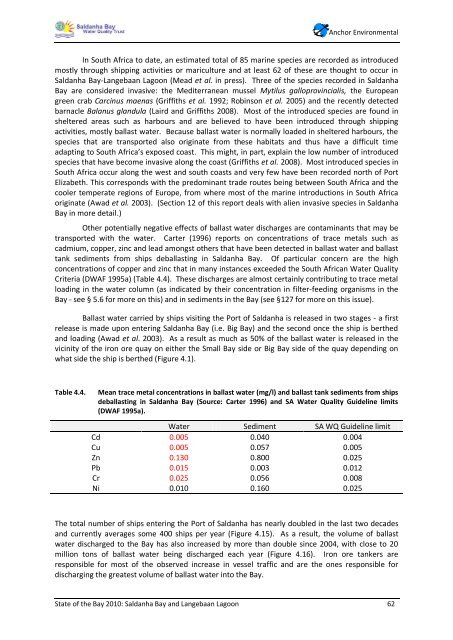State of the Bay Report 2010-Final - Anchor Environmental
State of the Bay Report 2010-Final - Anchor Environmental
State of the Bay Report 2010-Final - Anchor Environmental
You also want an ePaper? Increase the reach of your titles
YUMPU automatically turns print PDFs into web optimized ePapers that Google loves.
<strong>Anchor</strong> <strong>Environmental</strong><br />
In South Africa to date, an estimated total <strong>of</strong> 85 marine species are recorded as introduced<br />
mostly through shipping activities or mariculture and at least 62 <strong>of</strong> <strong>the</strong>se are thought to occur in<br />
Saldanha <strong>Bay</strong>-Langebaan Lagoon (Mead et al. in press). Three <strong>of</strong> <strong>the</strong> species recorded in Saldanha<br />
<strong>Bay</strong> are considered invasive: <strong>the</strong> Mediterranean mussel Mytilus galloprovincialis, <strong>the</strong> European<br />
green crab Carcinus maenas (Griffiths et al. 1992; Robinson et al. 2005) and <strong>the</strong> recently detected<br />
barnacle Balanus glandula (Laird and Griffiths 2008). Most <strong>of</strong> <strong>the</strong> introduced species are found in<br />
sheltered areas such as harbours and are believed to have been introduced through shipping<br />
activities, mostly ballast water. Because ballast water is normally loaded in sheltered harbours, <strong>the</strong><br />
species that are transported also originate from <strong>the</strong>se habitats and thus have a difficult time<br />
adapting to South Africa’s exposed coast. This might, in part, explain <strong>the</strong> low number <strong>of</strong> introduced<br />
species that have become invasive along <strong>the</strong> coast (Griffiths et al. 2008). Most introduced species in<br />
South Africa occur along <strong>the</strong> west and south coasts and very few have been recorded north <strong>of</strong> Port<br />
Elizabeth. This corresponds with <strong>the</strong> predominant trade routes being between South Africa and <strong>the</strong><br />
cooler temperate regions <strong>of</strong> Europe, from where most <strong>of</strong> <strong>the</strong> marine introductions in South Africa<br />
originate (Awad et al. 2003). (Section 12 <strong>of</strong> this report deals with alien invasive species in Saldanha<br />
<strong>Bay</strong> in more detail.)<br />
O<strong>the</strong>r potentially negative effects <strong>of</strong> ballast water discharges are contaminants that may be<br />
transported with <strong>the</strong> water. Carter (1996) reports on concentrations <strong>of</strong> trace metals such as<br />
cadmium, copper, zinc and lead amongst o<strong>the</strong>rs that have been detected in ballast water and ballast<br />
tank sediments from ships deballasting in Saldanha <strong>Bay</strong>. Of particular concern are <strong>the</strong> high<br />
concentrations <strong>of</strong> copper and zinc that in many instances exceeded <strong>the</strong> South African Water Quality<br />
Criteria (DWAF 1995a) (Table 4.4). These discharges are almost certainly contributing to trace metal<br />
loading in <strong>the</strong> water column (as indicated by <strong>the</strong>ir concentration in filter-feeding organisms in <strong>the</strong><br />
<strong>Bay</strong> - see § 5.6 for more on this) and in sediments in <strong>the</strong> <strong>Bay</strong> (see §127 for more on this issue).<br />
Ballast water carried by ships visiting <strong>the</strong> Port <strong>of</strong> Saldanha is released in two stages - a first<br />
release is made upon entering Saldanha <strong>Bay</strong> (i.e. Big <strong>Bay</strong>) and <strong>the</strong> second once <strong>the</strong> ship is ber<strong>the</strong>d<br />
and loading (Awad et al. 2003). As a result as much as 50% <strong>of</strong> <strong>the</strong> ballast water is released in <strong>the</strong><br />
vicinity <strong>of</strong> <strong>the</strong> iron ore quay on ei<strong>the</strong>r <strong>the</strong> Small <strong>Bay</strong> side or Big <strong>Bay</strong> side <strong>of</strong> <strong>the</strong> quay depending on<br />
what side <strong>the</strong> ship is ber<strong>the</strong>d (Figure 4.1).<br />
Table 4.4. Mean trace metal concentrations in ballast water (mg/l) and ballast tank sediments from ships<br />
deballasting in Saldanha <strong>Bay</strong> (Source: Carter 1996) and SA Water Quality Guideline limits<br />
(DWAF 1995a).<br />
Water Sediment SA WQ Guideline limit<br />
Cd 0.005 0.040 0.004<br />
Cu 0.005 0.057 0.005<br />
Zn 0.130 0.800 0.025<br />
Pb 0.015 0.003 0.012<br />
Cr 0.025 0.056 0.008<br />
Ni 0.010 0.160 0.025<br />
The total number <strong>of</strong> ships entering <strong>the</strong> Port <strong>of</strong> Saldanha has nearly doubled in <strong>the</strong> last two decades<br />
and currently averages some 400 ships per year (Figure 4.15). As a result, <strong>the</strong> volume <strong>of</strong> ballast<br />
water discharged to <strong>the</strong> <strong>Bay</strong> has also increased by more than double since 2004, with close to 20<br />
million tons <strong>of</strong> ballast water being discharged each year (Figure 4.16). Iron ore tankers are<br />
responsible for most <strong>of</strong> <strong>the</strong> observed increase in vessel traffic and are <strong>the</strong> ones responsible for<br />
discharging <strong>the</strong> greatest volume <strong>of</strong> ballast water into <strong>the</strong> <strong>Bay</strong>.<br />
<strong>State</strong> <strong>of</strong> <strong>the</strong> <strong>Bay</strong> <strong>2010</strong>: Saldanha <strong>Bay</strong> and Langebaan Lagoon 62

















